Enterprise Resource Planning Systems: Benefits and Weaknesses of On-Premise, Hosted, and Cloud Options
VerifiedAdded on 2023/06/07
|19
|5221
|343
AI Summary
This report provides an overview of Enterprise Resource Planning (ERP) systems and the different options available, including on-premise, hosted, and cloud ERP systems. It discusses the benefits and weaknesses of each option and factors to consider when adopting ERP systems. The report also includes a literature review and research methodology. The subject is ERP systems and the course code, name, and college/university are not mentioned.
Contribute Materials
Your contribution can guide someone’s learning journey. Share your
documents today.
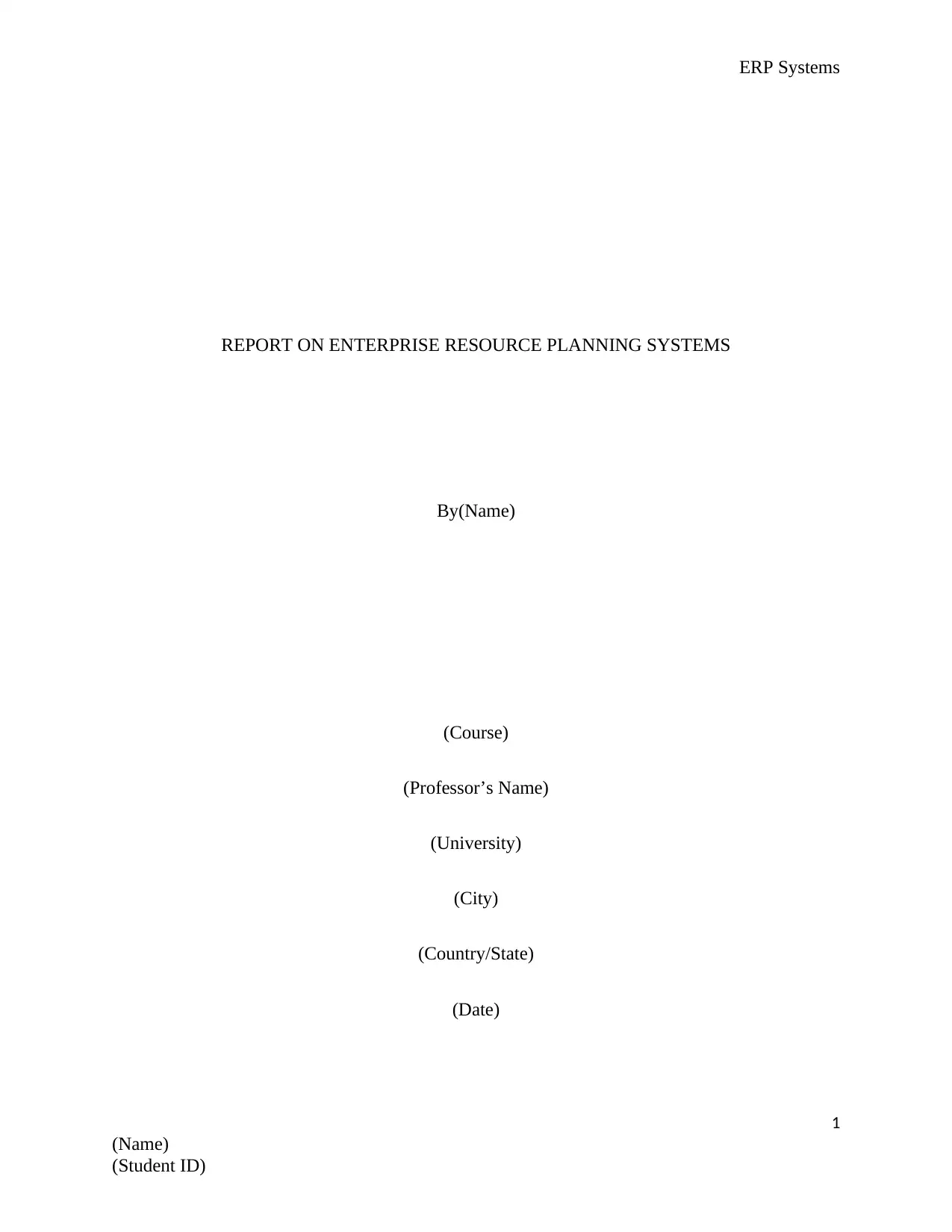
ERP Systems
REPORT ON ENTERPRISE RESOURCE PLANNING SYSTEMS
By(Name)
(Course)
(Professor’s Name)
(University)
(City)
(Country/State)
(Date)
1
(Name)
(Student ID)
REPORT ON ENTERPRISE RESOURCE PLANNING SYSTEMS
By(Name)
(Course)
(Professor’s Name)
(University)
(City)
(Country/State)
(Date)
1
(Name)
(Student ID)
Secure Best Marks with AI Grader
Need help grading? Try our AI Grader for instant feedback on your assignments.
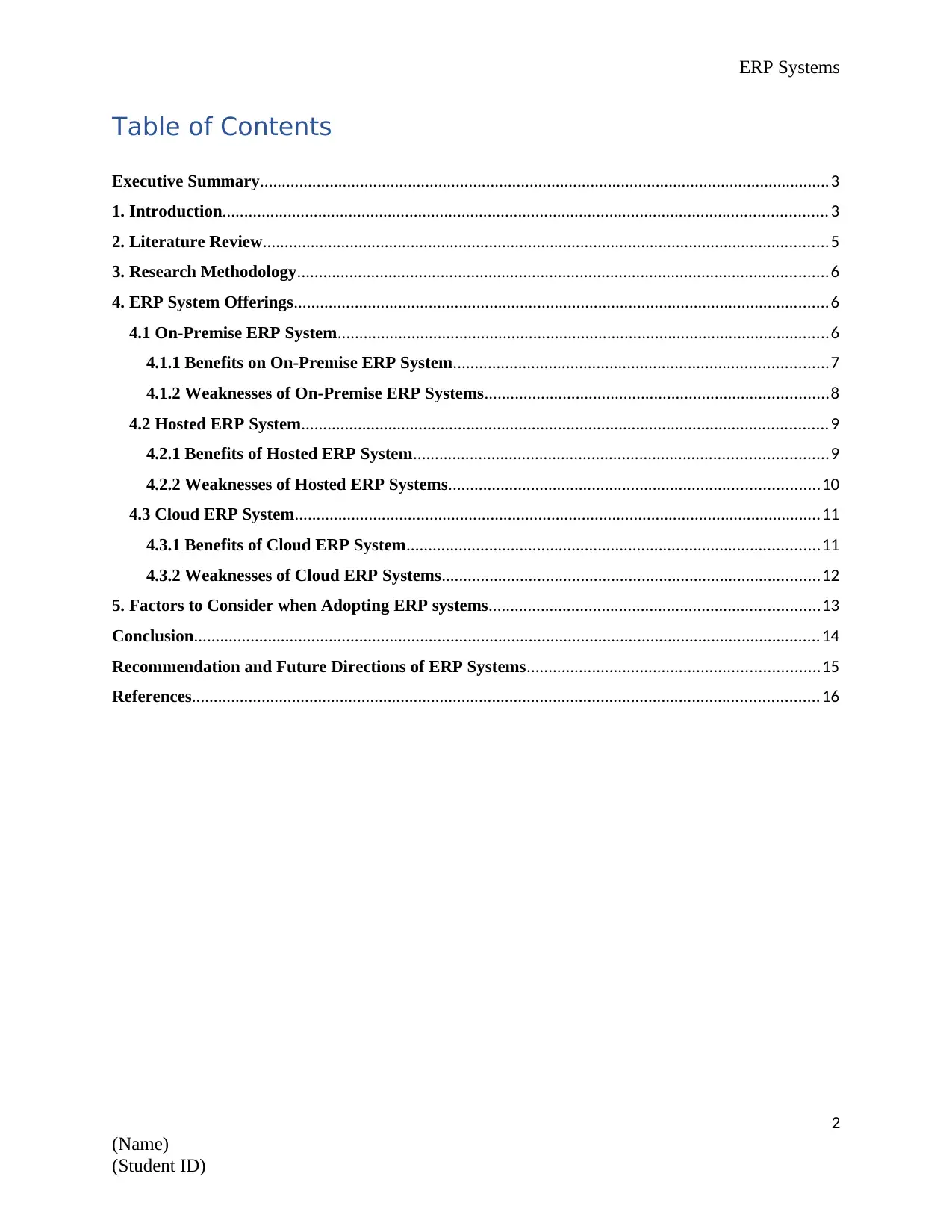
ERP Systems
Table of Contents
Executive Summary...................................................................................................................................3
1. Introduction...........................................................................................................................................3
2. Literature Review..................................................................................................................................5
3. Research Methodology..........................................................................................................................6
4. ERP System Offerings...........................................................................................................................6
4.1 On-Premise ERP System.................................................................................................................6
4.1.1 Benefits on On-Premise ERP System......................................................................................7
4.1.2 Weaknesses of On-Premise ERP Systems...............................................................................8
4.2 Hosted ERP System.........................................................................................................................9
4.2.1 Benefits of Hosted ERP System...............................................................................................9
4.2.2 Weaknesses of Hosted ERP Systems.....................................................................................10
4.3 Cloud ERP System.........................................................................................................................11
4.3.1 Benefits of Cloud ERP System...............................................................................................11
4.3.2 Weaknesses of Cloud ERP Systems.......................................................................................12
5. Factors to Consider when Adopting ERP systems............................................................................13
Conclusion................................................................................................................................................14
Recommendation and Future Directions of ERP Systems...................................................................15
References................................................................................................................................................16
2
(Name)
(Student ID)
Table of Contents
Executive Summary...................................................................................................................................3
1. Introduction...........................................................................................................................................3
2. Literature Review..................................................................................................................................5
3. Research Methodology..........................................................................................................................6
4. ERP System Offerings...........................................................................................................................6
4.1 On-Premise ERP System.................................................................................................................6
4.1.1 Benefits on On-Premise ERP System......................................................................................7
4.1.2 Weaknesses of On-Premise ERP Systems...............................................................................8
4.2 Hosted ERP System.........................................................................................................................9
4.2.1 Benefits of Hosted ERP System...............................................................................................9
4.2.2 Weaknesses of Hosted ERP Systems.....................................................................................10
4.3 Cloud ERP System.........................................................................................................................11
4.3.1 Benefits of Cloud ERP System...............................................................................................11
4.3.2 Weaknesses of Cloud ERP Systems.......................................................................................12
5. Factors to Consider when Adopting ERP systems............................................................................13
Conclusion................................................................................................................................................14
Recommendation and Future Directions of ERP Systems...................................................................15
References................................................................................................................................................16
2
(Name)
(Student ID)
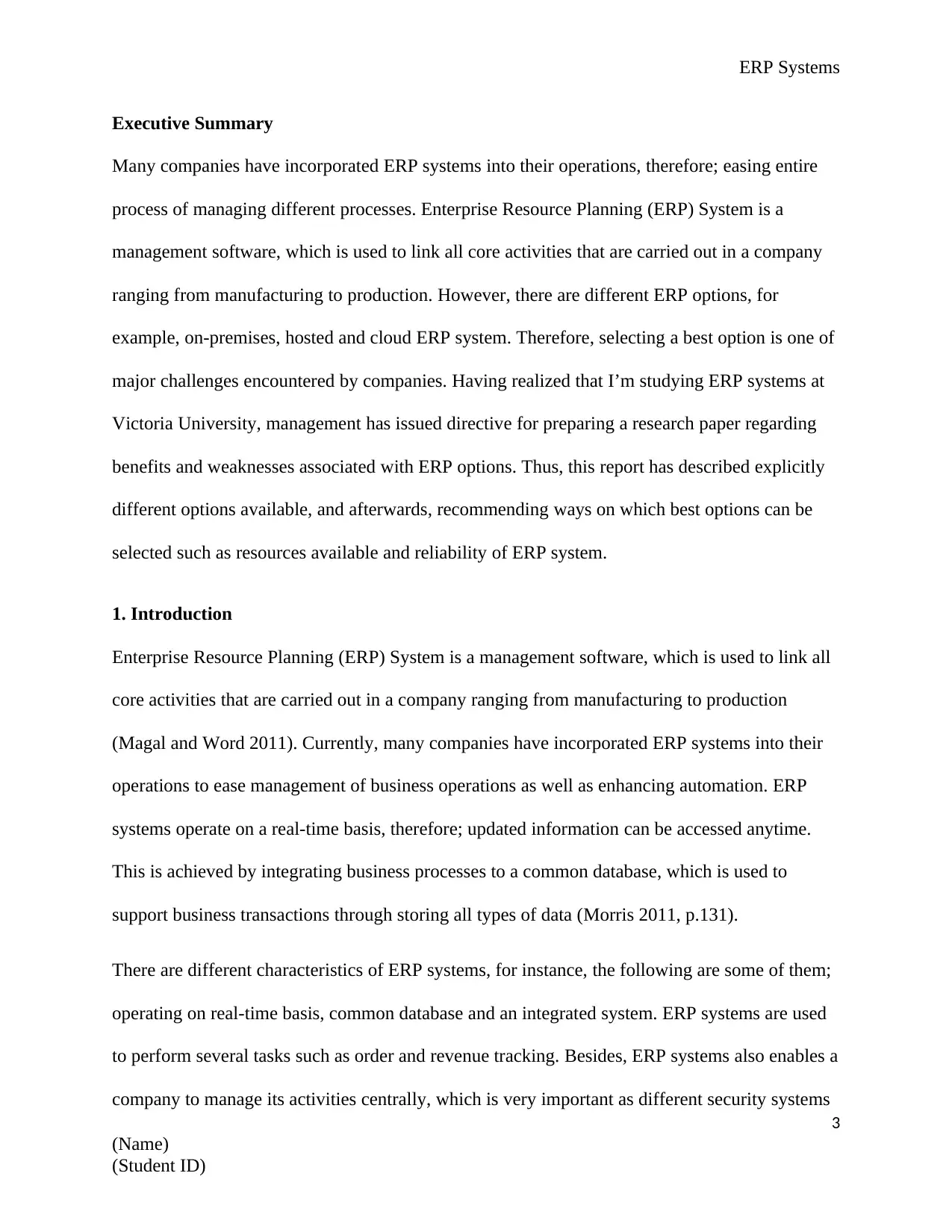
ERP Systems
Executive Summary
Many companies have incorporated ERP systems into their operations, therefore; easing entire
process of managing different processes. Enterprise Resource Planning (ERP) System is a
management software, which is used to link all core activities that are carried out in a company
ranging from manufacturing to production. However, there are different ERP options, for
example, on-premises, hosted and cloud ERP system. Therefore, selecting a best option is one of
major challenges encountered by companies. Having realized that I’m studying ERP systems at
Victoria University, management has issued directive for preparing a research paper regarding
benefits and weaknesses associated with ERP options. Thus, this report has described explicitly
different options available, and afterwards, recommending ways on which best options can be
selected such as resources available and reliability of ERP system.
1. Introduction
Enterprise Resource Planning (ERP) System is a management software, which is used to link all
core activities that are carried out in a company ranging from manufacturing to production
(Magal and Word 2011). Currently, many companies have incorporated ERP systems into their
operations to ease management of business operations as well as enhancing automation. ERP
systems operate on a real-time basis, therefore; updated information can be accessed anytime.
This is achieved by integrating business processes to a common database, which is used to
support business transactions through storing all types of data (Morris 2011, p.131).
There are different characteristics of ERP systems, for instance, the following are some of them;
operating on real-time basis, common database and an integrated system. ERP systems are used
to perform several tasks such as order and revenue tracking. Besides, ERP systems also enables a
company to manage its activities centrally, which is very important as different security systems
3
(Name)
(Student ID)
Executive Summary
Many companies have incorporated ERP systems into their operations, therefore; easing entire
process of managing different processes. Enterprise Resource Planning (ERP) System is a
management software, which is used to link all core activities that are carried out in a company
ranging from manufacturing to production. However, there are different ERP options, for
example, on-premises, hosted and cloud ERP system. Therefore, selecting a best option is one of
major challenges encountered by companies. Having realized that I’m studying ERP systems at
Victoria University, management has issued directive for preparing a research paper regarding
benefits and weaknesses associated with ERP options. Thus, this report has described explicitly
different options available, and afterwards, recommending ways on which best options can be
selected such as resources available and reliability of ERP system.
1. Introduction
Enterprise Resource Planning (ERP) System is a management software, which is used to link all
core activities that are carried out in a company ranging from manufacturing to production
(Magal and Word 2011). Currently, many companies have incorporated ERP systems into their
operations to ease management of business operations as well as enhancing automation. ERP
systems operate on a real-time basis, therefore; updated information can be accessed anytime.
This is achieved by integrating business processes to a common database, which is used to
support business transactions through storing all types of data (Morris 2011, p.131).
There are different characteristics of ERP systems, for instance, the following are some of them;
operating on real-time basis, common database and an integrated system. ERP systems are used
to perform several tasks such as order and revenue tracking. Besides, ERP systems also enables a
company to manage its activities centrally, which is very important as different security systems
3
(Name)
(Student ID)
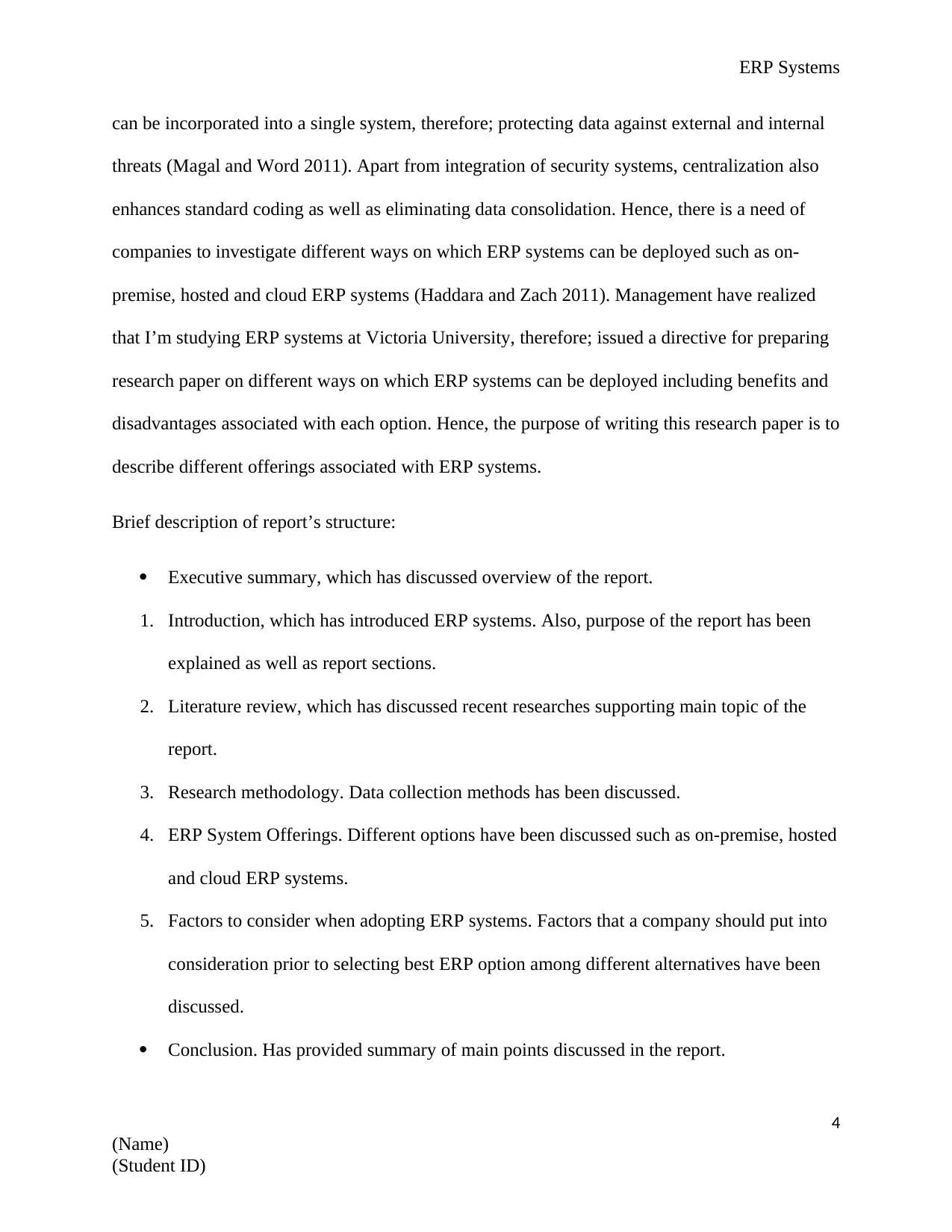
ERP Systems
can be incorporated into a single system, therefore; protecting data against external and internal
threats (Magal and Word 2011). Apart from integration of security systems, centralization also
enhances standard coding as well as eliminating data consolidation. Hence, there is a need of
companies to investigate different ways on which ERP systems can be deployed such as on-
premise, hosted and cloud ERP systems (Haddara and Zach 2011). Management have realized
that I’m studying ERP systems at Victoria University, therefore; issued a directive for preparing
research paper on different ways on which ERP systems can be deployed including benefits and
disadvantages associated with each option. Hence, the purpose of writing this research paper is to
describe different offerings associated with ERP systems.
Brief description of report’s structure:
Executive summary, which has discussed overview of the report.
1. Introduction, which has introduced ERP systems. Also, purpose of the report has been
explained as well as report sections.
2. Literature review, which has discussed recent researches supporting main topic of the
report.
3. Research methodology. Data collection methods has been discussed.
4. ERP System Offerings. Different options have been discussed such as on-premise, hosted
and cloud ERP systems.
5. Factors to consider when adopting ERP systems. Factors that a company should put into
consideration prior to selecting best ERP option among different alternatives have been
discussed.
Conclusion. Has provided summary of main points discussed in the report.
4
(Name)
(Student ID)
can be incorporated into a single system, therefore; protecting data against external and internal
threats (Magal and Word 2011). Apart from integration of security systems, centralization also
enhances standard coding as well as eliminating data consolidation. Hence, there is a need of
companies to investigate different ways on which ERP systems can be deployed such as on-
premise, hosted and cloud ERP systems (Haddara and Zach 2011). Management have realized
that I’m studying ERP systems at Victoria University, therefore; issued a directive for preparing
research paper on different ways on which ERP systems can be deployed including benefits and
disadvantages associated with each option. Hence, the purpose of writing this research paper is to
describe different offerings associated with ERP systems.
Brief description of report’s structure:
Executive summary, which has discussed overview of the report.
1. Introduction, which has introduced ERP systems. Also, purpose of the report has been
explained as well as report sections.
2. Literature review, which has discussed recent researches supporting main topic of the
report.
3. Research methodology. Data collection methods has been discussed.
4. ERP System Offerings. Different options have been discussed such as on-premise, hosted
and cloud ERP systems.
5. Factors to consider when adopting ERP systems. Factors that a company should put into
consideration prior to selecting best ERP option among different alternatives have been
discussed.
Conclusion. Has provided summary of main points discussed in the report.
4
(Name)
(Student ID)
Secure Best Marks with AI Grader
Need help grading? Try our AI Grader for instant feedback on your assignments.
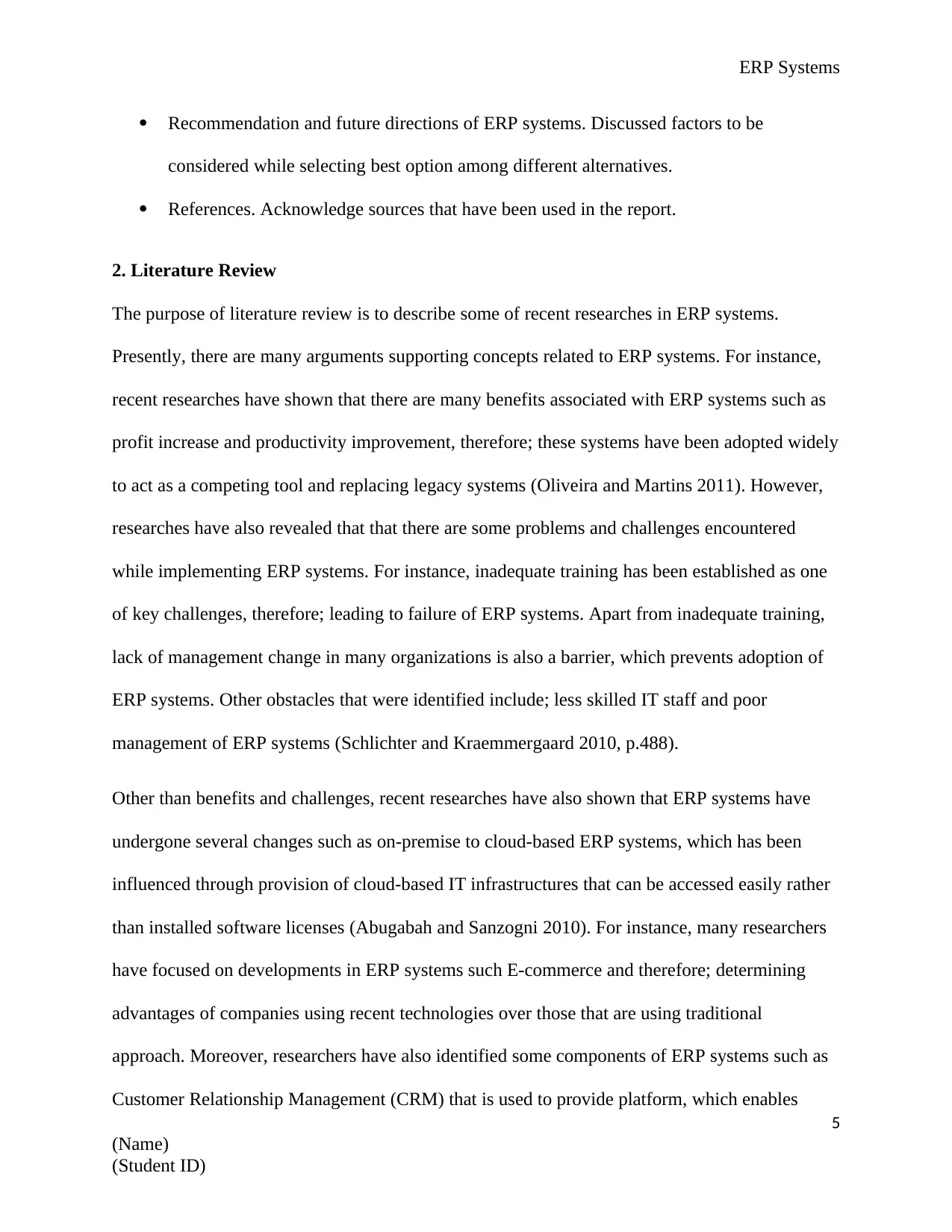
ERP Systems
Recommendation and future directions of ERP systems. Discussed factors to be
considered while selecting best option among different alternatives.
References. Acknowledge sources that have been used in the report.
2. Literature Review
The purpose of literature review is to describe some of recent researches in ERP systems.
Presently, there are many arguments supporting concepts related to ERP systems. For instance,
recent researches have shown that there are many benefits associated with ERP systems such as
profit increase and productivity improvement, therefore; these systems have been adopted widely
to act as a competing tool and replacing legacy systems (Oliveira and Martins 2011). However,
researches have also revealed that that there are some problems and challenges encountered
while implementing ERP systems. For instance, inadequate training has been established as one
of key challenges, therefore; leading to failure of ERP systems. Apart from inadequate training,
lack of management change in many organizations is also a barrier, which prevents adoption of
ERP systems. Other obstacles that were identified include; less skilled IT staff and poor
management of ERP systems (Schlichter and Kraemmergaard 2010, p.488).
Other than benefits and challenges, recent researches have also shown that ERP systems have
undergone several changes such as on-premise to cloud-based ERP systems, which has been
influenced through provision of cloud-based IT infrastructures that can be accessed easily rather
than installed software licenses (Abugabah and Sanzogni 2010). For instance, many researchers
have focused on developments in ERP systems such E-commerce and therefore; determining
advantages of companies using recent technologies over those that are using traditional
approach. Moreover, researchers have also identified some components of ERP systems such as
Customer Relationship Management (CRM) that is used to provide platform, which enables
5
(Name)
(Student ID)
Recommendation and future directions of ERP systems. Discussed factors to be
considered while selecting best option among different alternatives.
References. Acknowledge sources that have been used in the report.
2. Literature Review
The purpose of literature review is to describe some of recent researches in ERP systems.
Presently, there are many arguments supporting concepts related to ERP systems. For instance,
recent researches have shown that there are many benefits associated with ERP systems such as
profit increase and productivity improvement, therefore; these systems have been adopted widely
to act as a competing tool and replacing legacy systems (Oliveira and Martins 2011). However,
researches have also revealed that that there are some problems and challenges encountered
while implementing ERP systems. For instance, inadequate training has been established as one
of key challenges, therefore; leading to failure of ERP systems. Apart from inadequate training,
lack of management change in many organizations is also a barrier, which prevents adoption of
ERP systems. Other obstacles that were identified include; less skilled IT staff and poor
management of ERP systems (Schlichter and Kraemmergaard 2010, p.488).
Other than benefits and challenges, recent researches have also shown that ERP systems have
undergone several changes such as on-premise to cloud-based ERP systems, which has been
influenced through provision of cloud-based IT infrastructures that can be accessed easily rather
than installed software licenses (Abugabah and Sanzogni 2010). For instance, many researchers
have focused on developments in ERP systems such E-commerce and therefore; determining
advantages of companies using recent technologies over those that are using traditional
approach. Moreover, researchers have also identified some components of ERP systems such as
Customer Relationship Management (CRM) that is used to provide platform, which enables
5
(Name)
(Student ID)
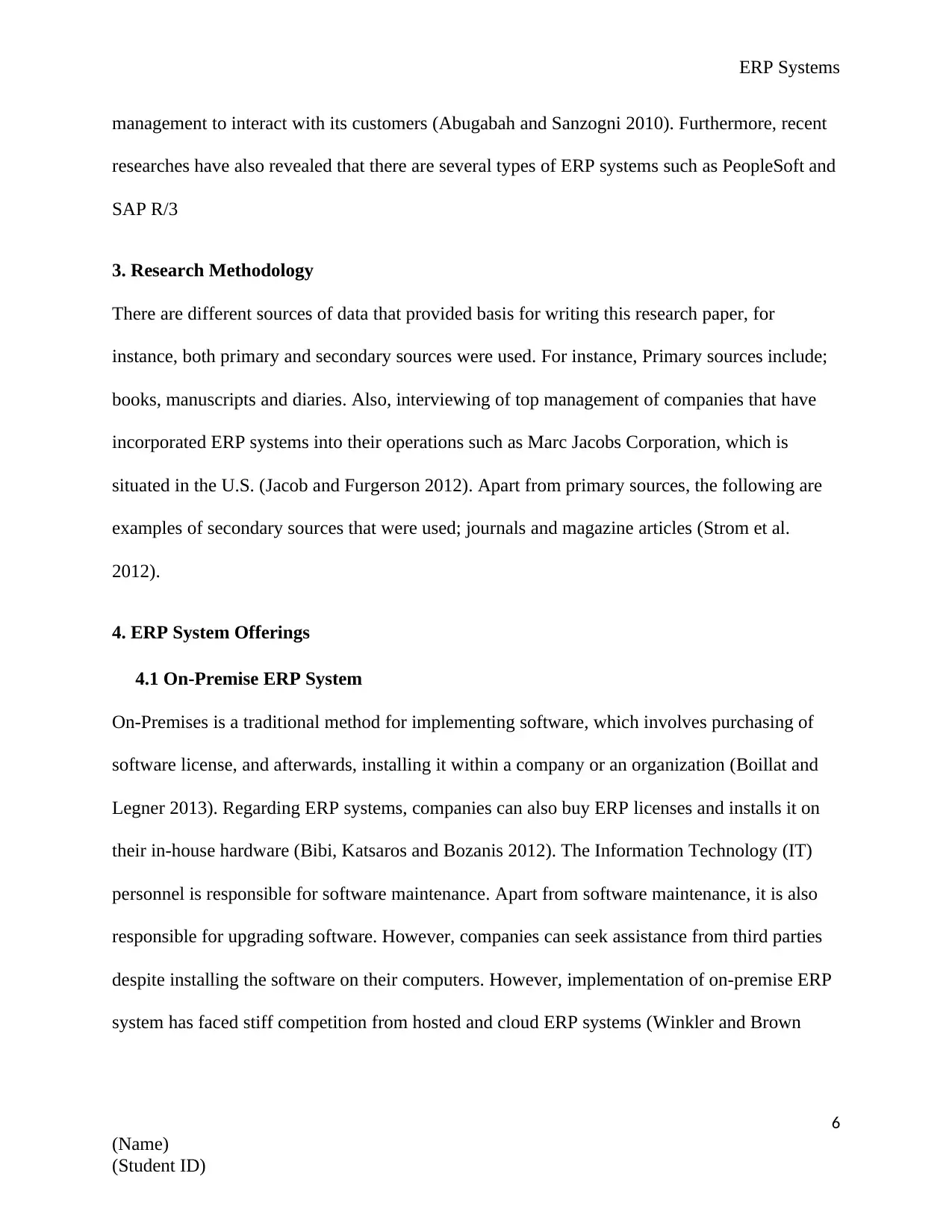
ERP Systems
management to interact with its customers (Abugabah and Sanzogni 2010). Furthermore, recent
researches have also revealed that there are several types of ERP systems such as PeopleSoft and
SAP R/3
3. Research Methodology
There are different sources of data that provided basis for writing this research paper, for
instance, both primary and secondary sources were used. For instance, Primary sources include;
books, manuscripts and diaries. Also, interviewing of top management of companies that have
incorporated ERP systems into their operations such as Marc Jacobs Corporation, which is
situated in the U.S. (Jacob and Furgerson 2012). Apart from primary sources, the following are
examples of secondary sources that were used; journals and magazine articles (Strom et al.
2012).
4. ERP System Offerings
4.1 On-Premise ERP System
On-Premises is a traditional method for implementing software, which involves purchasing of
software license, and afterwards, installing it within a company or an organization (Boillat and
Legner 2013). Regarding ERP systems, companies can also buy ERP licenses and installs it on
their in-house hardware (Bibi, Katsaros and Bozanis 2012). The Information Technology (IT)
personnel is responsible for software maintenance. Apart from software maintenance, it is also
responsible for upgrading software. However, companies can seek assistance from third parties
despite installing the software on their computers. However, implementation of on-premise ERP
system has faced stiff competition from hosted and cloud ERP systems (Winkler and Brown
6
(Name)
(Student ID)
management to interact with its customers (Abugabah and Sanzogni 2010). Furthermore, recent
researches have also revealed that there are several types of ERP systems such as PeopleSoft and
SAP R/3
3. Research Methodology
There are different sources of data that provided basis for writing this research paper, for
instance, both primary and secondary sources were used. For instance, Primary sources include;
books, manuscripts and diaries. Also, interviewing of top management of companies that have
incorporated ERP systems into their operations such as Marc Jacobs Corporation, which is
situated in the U.S. (Jacob and Furgerson 2012). Apart from primary sources, the following are
examples of secondary sources that were used; journals and magazine articles (Strom et al.
2012).
4. ERP System Offerings
4.1 On-Premise ERP System
On-Premises is a traditional method for implementing software, which involves purchasing of
software license, and afterwards, installing it within a company or an organization (Boillat and
Legner 2013). Regarding ERP systems, companies can also buy ERP licenses and installs it on
their in-house hardware (Bibi, Katsaros and Bozanis 2012). The Information Technology (IT)
personnel is responsible for software maintenance. Apart from software maintenance, it is also
responsible for upgrading software. However, companies can seek assistance from third parties
despite installing the software on their computers. However, implementation of on-premise ERP
system has faced stiff competition from hosted and cloud ERP systems (Winkler and Brown
6
(Name)
(Student ID)
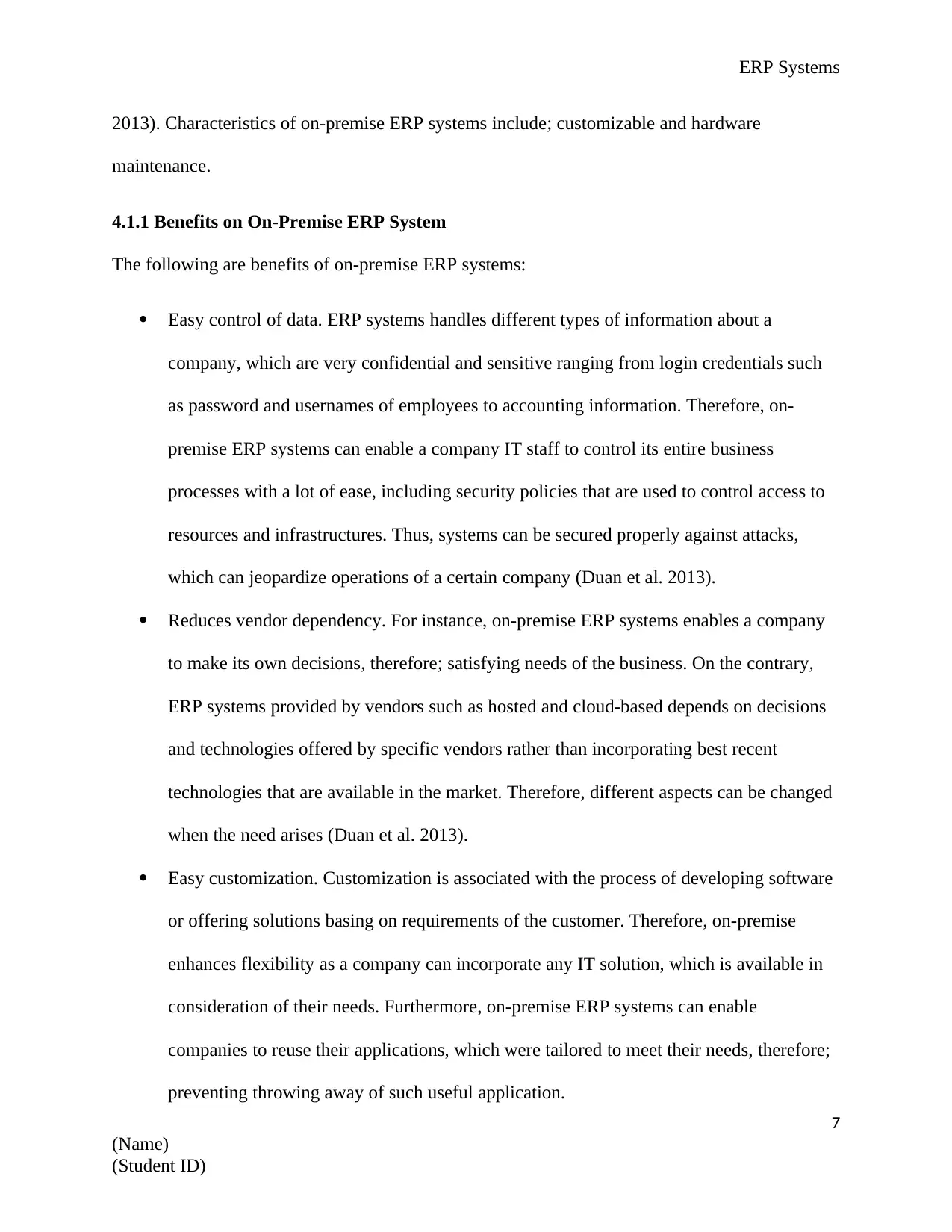
ERP Systems
2013). Characteristics of on-premise ERP systems include; customizable and hardware
maintenance.
4.1.1 Benefits on On-Premise ERP System
The following are benefits of on-premise ERP systems:
Easy control of data. ERP systems handles different types of information about a
company, which are very confidential and sensitive ranging from login credentials such
as password and usernames of employees to accounting information. Therefore, on-
premise ERP systems can enable a company IT staff to control its entire business
processes with a lot of ease, including security policies that are used to control access to
resources and infrastructures. Thus, systems can be secured properly against attacks,
which can jeopardize operations of a certain company (Duan et al. 2013).
Reduces vendor dependency. For instance, on-premise ERP systems enables a company
to make its own decisions, therefore; satisfying needs of the business. On the contrary,
ERP systems provided by vendors such as hosted and cloud-based depends on decisions
and technologies offered by specific vendors rather than incorporating best recent
technologies that are available in the market. Therefore, different aspects can be changed
when the need arises (Duan et al. 2013).
Easy customization. Customization is associated with the process of developing software
or offering solutions basing on requirements of the customer. Therefore, on-premise
enhances flexibility as a company can incorporate any IT solution, which is available in
consideration of their needs. Furthermore, on-premise ERP systems can enable
companies to reuse their applications, which were tailored to meet their needs, therefore;
preventing throwing away of such useful application.
7
(Name)
(Student ID)
2013). Characteristics of on-premise ERP systems include; customizable and hardware
maintenance.
4.1.1 Benefits on On-Premise ERP System
The following are benefits of on-premise ERP systems:
Easy control of data. ERP systems handles different types of information about a
company, which are very confidential and sensitive ranging from login credentials such
as password and usernames of employees to accounting information. Therefore, on-
premise ERP systems can enable a company IT staff to control its entire business
processes with a lot of ease, including security policies that are used to control access to
resources and infrastructures. Thus, systems can be secured properly against attacks,
which can jeopardize operations of a certain company (Duan et al. 2013).
Reduces vendor dependency. For instance, on-premise ERP systems enables a company
to make its own decisions, therefore; satisfying needs of the business. On the contrary,
ERP systems provided by vendors such as hosted and cloud-based depends on decisions
and technologies offered by specific vendors rather than incorporating best recent
technologies that are available in the market. Therefore, different aspects can be changed
when the need arises (Duan et al. 2013).
Easy customization. Customization is associated with the process of developing software
or offering solutions basing on requirements of the customer. Therefore, on-premise
enhances flexibility as a company can incorporate any IT solution, which is available in
consideration of their needs. Furthermore, on-premise ERP systems can enable
companies to reuse their applications, which were tailored to meet their needs, therefore;
preventing throwing away of such useful application.
7
(Name)
(Student ID)
Paraphrase This Document
Need a fresh take? Get an instant paraphrase of this document with our AI Paraphraser

ERP Systems
Enhances sense of ownership. A company is entitled to all privileges and ownership
rights, which are associated with ERP systems (Benlian 2011).
4.1.2 Weaknesses of On-Premise ERP Systems
The following are weaknesses associated with on-premise ERP systems:
It’s expensive to install. For instance, there are different costs incurred while installing
on-premise ERP systems, for example, a company must purchase ERP software licenses,
which can be costly. Apart from licenses cost, a company also needs to buy necessary
hardware and infrastructures. Moreover, maintenance costs for hardware is also very
higher, therefore, rendering entire installation process as expensive (Bibi, Katsaros and
Bozanis 2012).
Takes a lot of time for implementation. There is a lot of complexity in configuring of
devices as well as customization. For instance, customization increases overall time for
upgrading ERP software since implementation requires some planning to enhance
effectiveness. Therefore, difficulties encountered increases implementation time (Bibi,
Katsaros and Bozanis 2012).
Difficulties in protecting data as security measures and policies are defined and
implemented internally. ERP security includes protection of hardware, which are used in
a company. Apart from hardware, facilities regarding data backup are also supposed to be
secured. Moreover, disaster discovery methods are also required to be identified and
implemented. Therefore, poor security management cam lead to data corruption, thus
resulting in issues related to integrity and availability (Bibi, Katsaros and Bozanis 2012).
Many resources are required for smooth running of ERP systems. For instance, recent IT
solutions require many resources, therefore; easing maintainability. Thus, less resources
8
(Name)
(Student ID)
Enhances sense of ownership. A company is entitled to all privileges and ownership
rights, which are associated with ERP systems (Benlian 2011).
4.1.2 Weaknesses of On-Premise ERP Systems
The following are weaknesses associated with on-premise ERP systems:
It’s expensive to install. For instance, there are different costs incurred while installing
on-premise ERP systems, for example, a company must purchase ERP software licenses,
which can be costly. Apart from licenses cost, a company also needs to buy necessary
hardware and infrastructures. Moreover, maintenance costs for hardware is also very
higher, therefore, rendering entire installation process as expensive (Bibi, Katsaros and
Bozanis 2012).
Takes a lot of time for implementation. There is a lot of complexity in configuring of
devices as well as customization. For instance, customization increases overall time for
upgrading ERP software since implementation requires some planning to enhance
effectiveness. Therefore, difficulties encountered increases implementation time (Bibi,
Katsaros and Bozanis 2012).
Difficulties in protecting data as security measures and policies are defined and
implemented internally. ERP security includes protection of hardware, which are used in
a company. Apart from hardware, facilities regarding data backup are also supposed to be
secured. Moreover, disaster discovery methods are also required to be identified and
implemented. Therefore, poor security management cam lead to data corruption, thus
resulting in issues related to integrity and availability (Bibi, Katsaros and Bozanis 2012).
Many resources are required for smooth running of ERP systems. For instance, recent IT
solutions require many resources, therefore; easing maintainability. Thus, less resources
8
(Name)
(Student ID)

ERP Systems
can interfere with smooth running of business processes. On the other hand, many
resources reduce space and increases overall costs required for running ERP systems
(Bibi, Katsaros and Bozanis 2012).
4.2 Hosted ERP System
Hosted ERP systems involves purchasing of ERP licenses, and afterwards, installing it on cloud-
based infrastructures, which are provided with third parties (Lenart 2011). It is also referred to as
Infrastructure as a Service (IaaS). A company can access solutions from dedicated servers if
there is an internet connection. Software maintenance is done by a third party on the contrary to
on-premise ERP systems. However, a company is entitled to software ownership privileges, for
instance, management can choose whether to upgrade it or not (Al-Ghofaili and Al-Mashari
2014).
4.2.1 Benefits of Hosted ERP System
The following are benefits of hosted ERP systems:
Cost savings. For instance, initial costs, which are incurred by a company are very less,
therefore, easily affordable (Developing 2013).
Easy accessibility. For instance, access to ERP systems is not confined at a specific place
or device, therefore; enabling a company to access it from anywhere, thus reducing
problems related with data unavailability. Also, easy accessibility ensures smooth
running of business processes as data is available when the need arises.
Reduced maintenance issues. A third party is responsible for updating ERP software.
Therefore, a company focuses on achieving its objectives rather than managing ERP
systems. Hence, increasing productivity (Makkar and Bist 2012).
9
(Name)
(Student ID)
can interfere with smooth running of business processes. On the other hand, many
resources reduce space and increases overall costs required for running ERP systems
(Bibi, Katsaros and Bozanis 2012).
4.2 Hosted ERP System
Hosted ERP systems involves purchasing of ERP licenses, and afterwards, installing it on cloud-
based infrastructures, which are provided with third parties (Lenart 2011). It is also referred to as
Infrastructure as a Service (IaaS). A company can access solutions from dedicated servers if
there is an internet connection. Software maintenance is done by a third party on the contrary to
on-premise ERP systems. However, a company is entitled to software ownership privileges, for
instance, management can choose whether to upgrade it or not (Al-Ghofaili and Al-Mashari
2014).
4.2.1 Benefits of Hosted ERP System
The following are benefits of hosted ERP systems:
Cost savings. For instance, initial costs, which are incurred by a company are very less,
therefore, easily affordable (Developing 2013).
Easy accessibility. For instance, access to ERP systems is not confined at a specific place
or device, therefore; enabling a company to access it from anywhere, thus reducing
problems related with data unavailability. Also, easy accessibility ensures smooth
running of business processes as data is available when the need arises.
Reduced maintenance issues. A third party is responsible for updating ERP software.
Therefore, a company focuses on achieving its objectives rather than managing ERP
systems. Hence, increasing productivity (Makkar and Bist 2012).
9
(Name)
(Student ID)
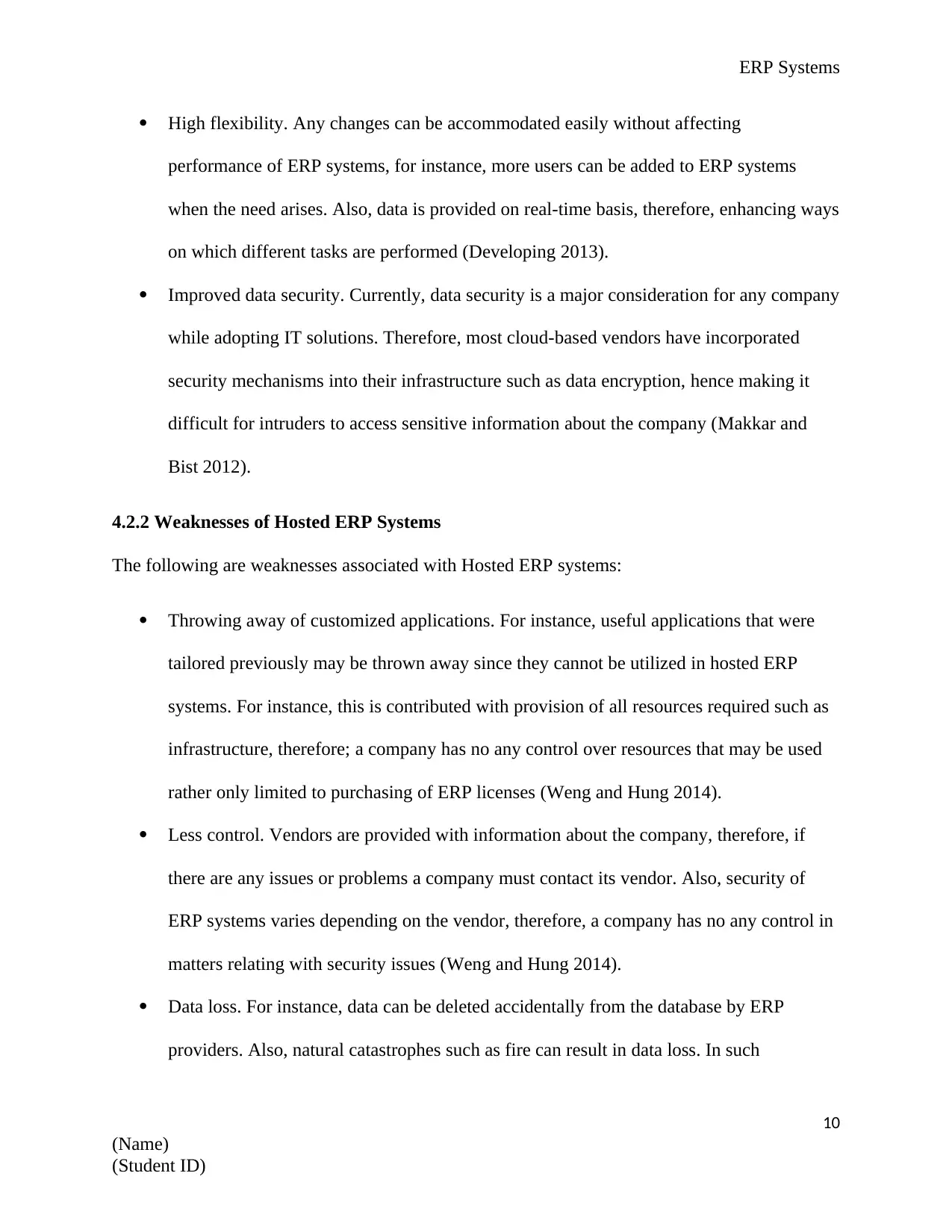
ERP Systems
High flexibility. Any changes can be accommodated easily without affecting
performance of ERP systems, for instance, more users can be added to ERP systems
when the need arises. Also, data is provided on real-time basis, therefore, enhancing ways
on which different tasks are performed (Developing 2013).
Improved data security. Currently, data security is a major consideration for any company
while adopting IT solutions. Therefore, most cloud-based vendors have incorporated
security mechanisms into their infrastructure such as data encryption, hence making it
difficult for intruders to access sensitive information about the company (Makkar and
Bist 2012).
4.2.2 Weaknesses of Hosted ERP Systems
The following are weaknesses associated with Hosted ERP systems:
Throwing away of customized applications. For instance, useful applications that were
tailored previously may be thrown away since they cannot be utilized in hosted ERP
systems. For instance, this is contributed with provision of all resources required such as
infrastructure, therefore; a company has no any control over resources that may be used
rather only limited to purchasing of ERP licenses (Weng and Hung 2014).
Less control. Vendors are provided with information about the company, therefore, if
there are any issues or problems a company must contact its vendor. Also, security of
ERP systems varies depending on the vendor, therefore, a company has no any control in
matters relating with security issues (Weng and Hung 2014).
Data loss. For instance, data can be deleted accidentally from the database by ERP
providers. Also, natural catastrophes such as fire can result in data loss. In such
10
(Name)
(Student ID)
High flexibility. Any changes can be accommodated easily without affecting
performance of ERP systems, for instance, more users can be added to ERP systems
when the need arises. Also, data is provided on real-time basis, therefore, enhancing ways
on which different tasks are performed (Developing 2013).
Improved data security. Currently, data security is a major consideration for any company
while adopting IT solutions. Therefore, most cloud-based vendors have incorporated
security mechanisms into their infrastructure such as data encryption, hence making it
difficult for intruders to access sensitive information about the company (Makkar and
Bist 2012).
4.2.2 Weaknesses of Hosted ERP Systems
The following are weaknesses associated with Hosted ERP systems:
Throwing away of customized applications. For instance, useful applications that were
tailored previously may be thrown away since they cannot be utilized in hosted ERP
systems. For instance, this is contributed with provision of all resources required such as
infrastructure, therefore; a company has no any control over resources that may be used
rather only limited to purchasing of ERP licenses (Weng and Hung 2014).
Less control. Vendors are provided with information about the company, therefore, if
there are any issues or problems a company must contact its vendor. Also, security of
ERP systems varies depending on the vendor, therefore, a company has no any control in
matters relating with security issues (Weng and Hung 2014).
Data loss. For instance, data can be deleted accidentally from the database by ERP
providers. Also, natural catastrophes such as fire can result in data loss. In such
10
(Name)
(Student ID)
Secure Best Marks with AI Grader
Need help grading? Try our AI Grader for instant feedback on your assignments.
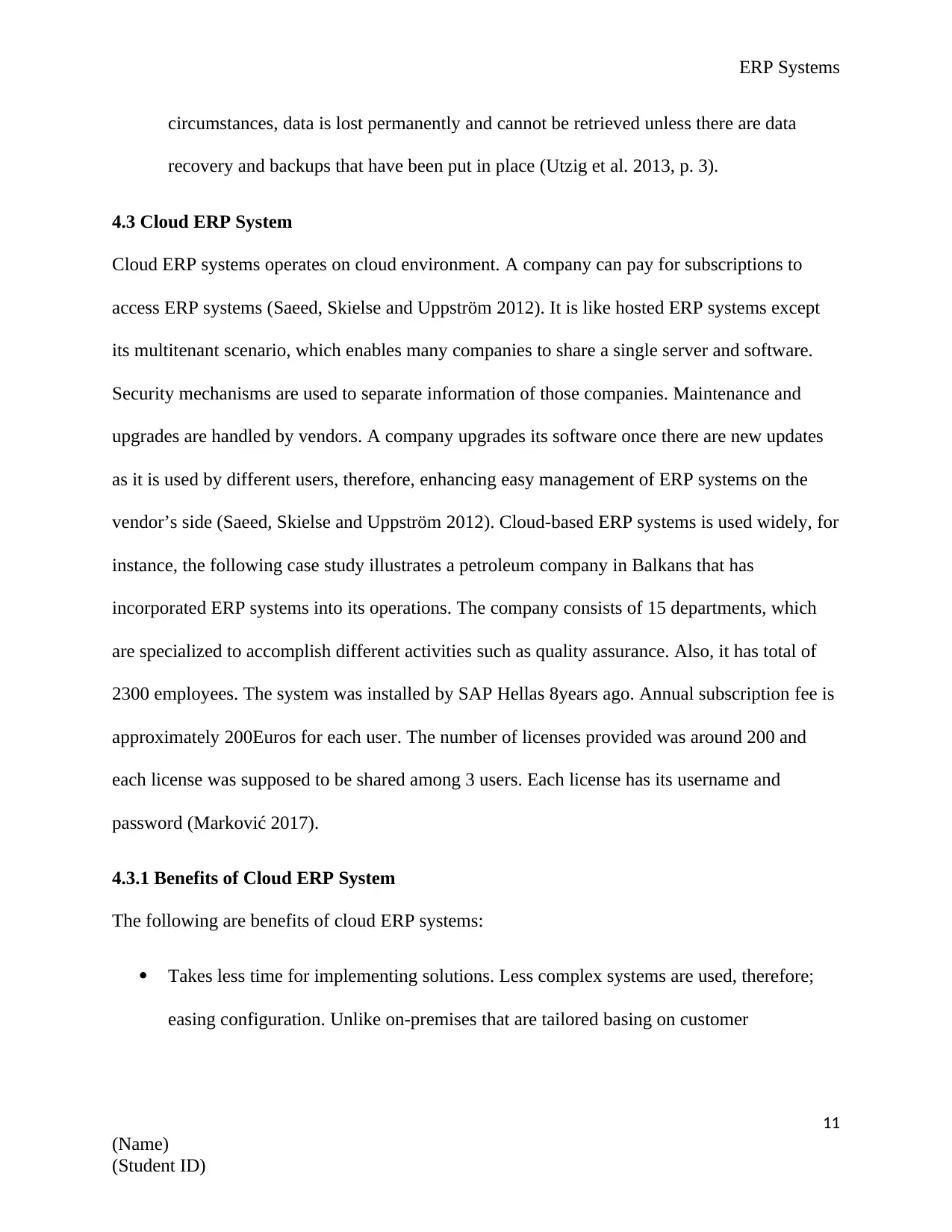
ERP Systems
circumstances, data is lost permanently and cannot be retrieved unless there are data
recovery and backups that have been put in place (Utzig et al. 2013, p. 3).
4.3 Cloud ERP System
Cloud ERP systems operates on cloud environment. A company can pay for subscriptions to
access ERP systems (Saeed, Skielse and Uppström 2012). It is like hosted ERP systems except
its multitenant scenario, which enables many companies to share a single server and software.
Security mechanisms are used to separate information of those companies. Maintenance and
upgrades are handled by vendors. A company upgrades its software once there are new updates
as it is used by different users, therefore, enhancing easy management of ERP systems on the
vendor’s side (Saeed, Skielse and Uppström 2012). Cloud-based ERP systems is used widely, for
instance, the following case study illustrates a petroleum company in Balkans that has
incorporated ERP systems into its operations. The company consists of 15 departments, which
are specialized to accomplish different activities such as quality assurance. Also, it has total of
2300 employees. The system was installed by SAP Hellas 8years ago. Annual subscription fee is
approximately 200Euros for each user. The number of licenses provided was around 200 and
each license was supposed to be shared among 3 users. Each license has its username and
password (Marković 2017).
4.3.1 Benefits of Cloud ERP System
The following are benefits of cloud ERP systems:
Takes less time for implementing solutions. Less complex systems are used, therefore;
easing configuration. Unlike on-premises that are tailored basing on customer
11
(Name)
(Student ID)
circumstances, data is lost permanently and cannot be retrieved unless there are data
recovery and backups that have been put in place (Utzig et al. 2013, p. 3).
4.3 Cloud ERP System
Cloud ERP systems operates on cloud environment. A company can pay for subscriptions to
access ERP systems (Saeed, Skielse and Uppström 2012). It is like hosted ERP systems except
its multitenant scenario, which enables many companies to share a single server and software.
Security mechanisms are used to separate information of those companies. Maintenance and
upgrades are handled by vendors. A company upgrades its software once there are new updates
as it is used by different users, therefore, enhancing easy management of ERP systems on the
vendor’s side (Saeed, Skielse and Uppström 2012). Cloud-based ERP systems is used widely, for
instance, the following case study illustrates a petroleum company in Balkans that has
incorporated ERP systems into its operations. The company consists of 15 departments, which
are specialized to accomplish different activities such as quality assurance. Also, it has total of
2300 employees. The system was installed by SAP Hellas 8years ago. Annual subscription fee is
approximately 200Euros for each user. The number of licenses provided was around 200 and
each license was supposed to be shared among 3 users. Each license has its username and
password (Marković 2017).
4.3.1 Benefits of Cloud ERP System
The following are benefits of cloud ERP systems:
Takes less time for implementing solutions. Less complex systems are used, therefore;
easing configuration. Unlike on-premises that are tailored basing on customer
11
(Name)
(Student ID)

ERP Systems
requirements, therefore; increasing time for implementation (Shukla, S., Agarwal and
Shukla, A. 2012, p. 8).
Initial costs incurred are very low as there is no need for purchasing infrastructures and
hardware. The only required costs incurred is subscription fee that can be easily
affordable (Shukla, S., Agarwal and Shukla, A. 2012, p. 8).
Data is owned by a company, therefore; it can opt to subscribe to other vendors once
subscription term has ended (Scholtz and Atukwase 2016).
Easy accessibility. For instance, access to ERP systems is not confined at a specific place
or device, therefore; enabling a company to access it from anywhere, thus reducing
problems related with data unavailability. Also, easy accessibility ensures smooth
running of business processes as data is available when the need arises.
Improved security. For instance, many vendors have invested much on security,
therefore, information about a company cannot leak to any of its competitors or hackers.
Also, there are data backups provided, hence corrupted data can be retrieved easily
(Scholtz and Atukwase 2016).
Minimizes risks. On-premises requires purchasing of infrastructures thus susceptible to
risks associated with compatibility and entire functionality of ERP systems. Also,
involves purchasing of servers. On the other side, cloud ERP systems doesn’t require
buying of hardware and other resources, therefore; management cannot take
responsibility of any risks that may be caused (Shukla, S., Agarwal and Shukla, A. 2012,
p. 8).
4.3.2 Weaknesses of Cloud ERP Systems
The following are weaknesses associated with cloud ERP systems:
12
(Name)
(Student ID)
requirements, therefore; increasing time for implementation (Shukla, S., Agarwal and
Shukla, A. 2012, p. 8).
Initial costs incurred are very low as there is no need for purchasing infrastructures and
hardware. The only required costs incurred is subscription fee that can be easily
affordable (Shukla, S., Agarwal and Shukla, A. 2012, p. 8).
Data is owned by a company, therefore; it can opt to subscribe to other vendors once
subscription term has ended (Scholtz and Atukwase 2016).
Easy accessibility. For instance, access to ERP systems is not confined at a specific place
or device, therefore; enabling a company to access it from anywhere, thus reducing
problems related with data unavailability. Also, easy accessibility ensures smooth
running of business processes as data is available when the need arises.
Improved security. For instance, many vendors have invested much on security,
therefore, information about a company cannot leak to any of its competitors or hackers.
Also, there are data backups provided, hence corrupted data can be retrieved easily
(Scholtz and Atukwase 2016).
Minimizes risks. On-premises requires purchasing of infrastructures thus susceptible to
risks associated with compatibility and entire functionality of ERP systems. Also,
involves purchasing of servers. On the other side, cloud ERP systems doesn’t require
buying of hardware and other resources, therefore; management cannot take
responsibility of any risks that may be caused (Shukla, S., Agarwal and Shukla, A. 2012,
p. 8).
4.3.2 Weaknesses of Cloud ERP Systems
The following are weaknesses associated with cloud ERP systems:
12
(Name)
(Student ID)
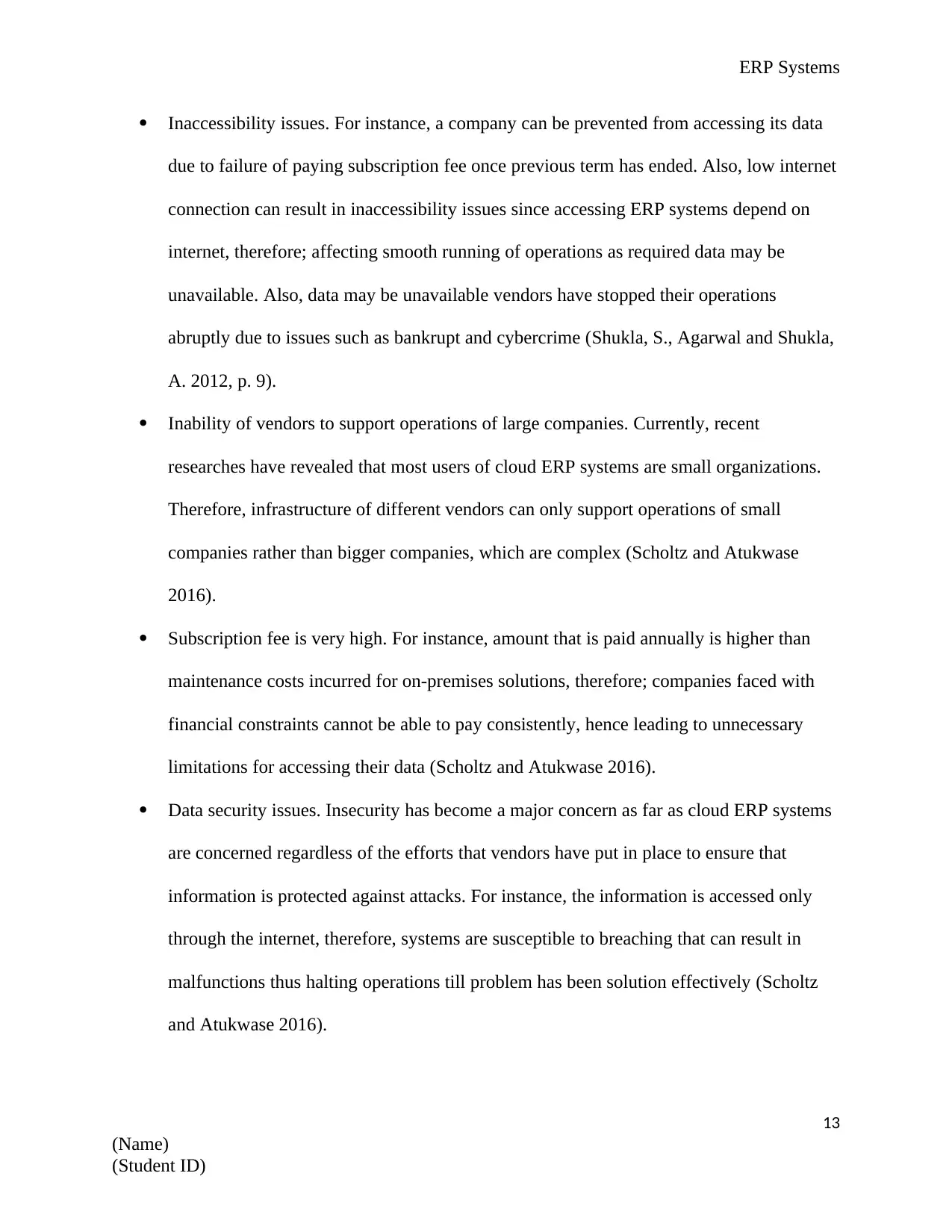
ERP Systems
Inaccessibility issues. For instance, a company can be prevented from accessing its data
due to failure of paying subscription fee once previous term has ended. Also, low internet
connection can result in inaccessibility issues since accessing ERP systems depend on
internet, therefore; affecting smooth running of operations as required data may be
unavailable. Also, data may be unavailable vendors have stopped their operations
abruptly due to issues such as bankrupt and cybercrime (Shukla, S., Agarwal and Shukla,
A. 2012, p. 9).
Inability of vendors to support operations of large companies. Currently, recent
researches have revealed that most users of cloud ERP systems are small organizations.
Therefore, infrastructure of different vendors can only support operations of small
companies rather than bigger companies, which are complex (Scholtz and Atukwase
2016).
Subscription fee is very high. For instance, amount that is paid annually is higher than
maintenance costs incurred for on-premises solutions, therefore; companies faced with
financial constraints cannot be able to pay consistently, hence leading to unnecessary
limitations for accessing their data (Scholtz and Atukwase 2016).
Data security issues. Insecurity has become a major concern as far as cloud ERP systems
are concerned regardless of the efforts that vendors have put in place to ensure that
information is protected against attacks. For instance, the information is accessed only
through the internet, therefore, systems are susceptible to breaching that can result in
malfunctions thus halting operations till problem has been solution effectively (Scholtz
and Atukwase 2016).
13
(Name)
(Student ID)
Inaccessibility issues. For instance, a company can be prevented from accessing its data
due to failure of paying subscription fee once previous term has ended. Also, low internet
connection can result in inaccessibility issues since accessing ERP systems depend on
internet, therefore; affecting smooth running of operations as required data may be
unavailable. Also, data may be unavailable vendors have stopped their operations
abruptly due to issues such as bankrupt and cybercrime (Shukla, S., Agarwal and Shukla,
A. 2012, p. 9).
Inability of vendors to support operations of large companies. Currently, recent
researches have revealed that most users of cloud ERP systems are small organizations.
Therefore, infrastructure of different vendors can only support operations of small
companies rather than bigger companies, which are complex (Scholtz and Atukwase
2016).
Subscription fee is very high. For instance, amount that is paid annually is higher than
maintenance costs incurred for on-premises solutions, therefore; companies faced with
financial constraints cannot be able to pay consistently, hence leading to unnecessary
limitations for accessing their data (Scholtz and Atukwase 2016).
Data security issues. Insecurity has become a major concern as far as cloud ERP systems
are concerned regardless of the efforts that vendors have put in place to ensure that
information is protected against attacks. For instance, the information is accessed only
through the internet, therefore, systems are susceptible to breaching that can result in
malfunctions thus halting operations till problem has been solution effectively (Scholtz
and Atukwase 2016).
13
(Name)
(Student ID)
Paraphrase This Document
Need a fresh take? Get an instant paraphrase of this document with our AI Paraphraser
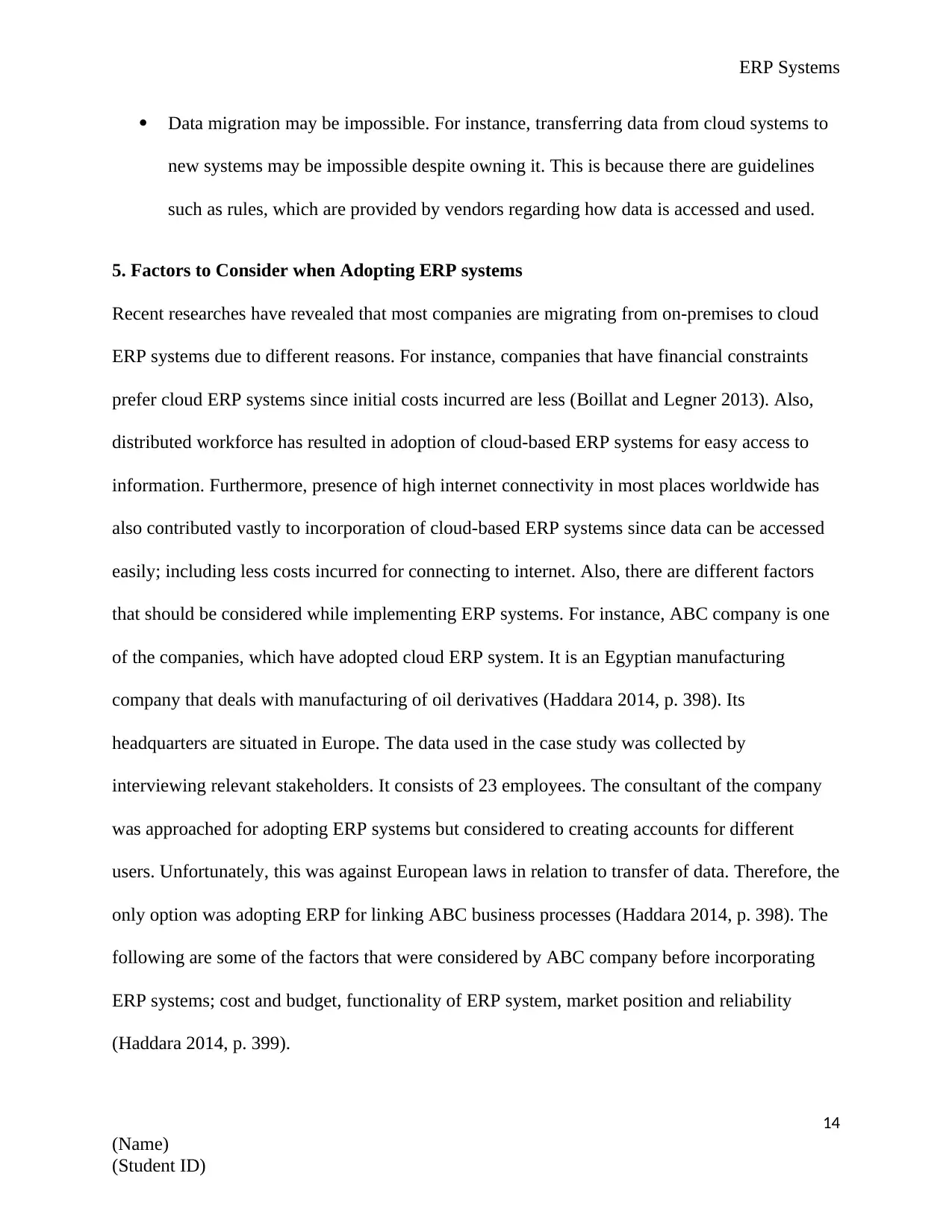
ERP Systems
Data migration may be impossible. For instance, transferring data from cloud systems to
new systems may be impossible despite owning it. This is because there are guidelines
such as rules, which are provided by vendors regarding how data is accessed and used.
5. Factors to Consider when Adopting ERP systems
Recent researches have revealed that most companies are migrating from on-premises to cloud
ERP systems due to different reasons. For instance, companies that have financial constraints
prefer cloud ERP systems since initial costs incurred are less (Boillat and Legner 2013). Also,
distributed workforce has resulted in adoption of cloud-based ERP systems for easy access to
information. Furthermore, presence of high internet connectivity in most places worldwide has
also contributed vastly to incorporation of cloud-based ERP systems since data can be accessed
easily; including less costs incurred for connecting to internet. Also, there are different factors
that should be considered while implementing ERP systems. For instance, ABC company is one
of the companies, which have adopted cloud ERP system. It is an Egyptian manufacturing
company that deals with manufacturing of oil derivatives (Haddara 2014, p. 398). Its
headquarters are situated in Europe. The data used in the case study was collected by
interviewing relevant stakeholders. It consists of 23 employees. The consultant of the company
was approached for adopting ERP systems but considered to creating accounts for different
users. Unfortunately, this was against European laws in relation to transfer of data. Therefore, the
only option was adopting ERP for linking ABC business processes (Haddara 2014, p. 398). The
following are some of the factors that were considered by ABC company before incorporating
ERP systems; cost and budget, functionality of ERP system, market position and reliability
(Haddara 2014, p. 399).
14
(Name)
(Student ID)
Data migration may be impossible. For instance, transferring data from cloud systems to
new systems may be impossible despite owning it. This is because there are guidelines
such as rules, which are provided by vendors regarding how data is accessed and used.
5. Factors to Consider when Adopting ERP systems
Recent researches have revealed that most companies are migrating from on-premises to cloud
ERP systems due to different reasons. For instance, companies that have financial constraints
prefer cloud ERP systems since initial costs incurred are less (Boillat and Legner 2013). Also,
distributed workforce has resulted in adoption of cloud-based ERP systems for easy access to
information. Furthermore, presence of high internet connectivity in most places worldwide has
also contributed vastly to incorporation of cloud-based ERP systems since data can be accessed
easily; including less costs incurred for connecting to internet. Also, there are different factors
that should be considered while implementing ERP systems. For instance, ABC company is one
of the companies, which have adopted cloud ERP system. It is an Egyptian manufacturing
company that deals with manufacturing of oil derivatives (Haddara 2014, p. 398). Its
headquarters are situated in Europe. The data used in the case study was collected by
interviewing relevant stakeholders. It consists of 23 employees. The consultant of the company
was approached for adopting ERP systems but considered to creating accounts for different
users. Unfortunately, this was against European laws in relation to transfer of data. Therefore, the
only option was adopting ERP for linking ABC business processes (Haddara 2014, p. 398). The
following are some of the factors that were considered by ABC company before incorporating
ERP systems; cost and budget, functionality of ERP system, market position and reliability
(Haddara 2014, p. 399).
14
(Name)
(Student ID)
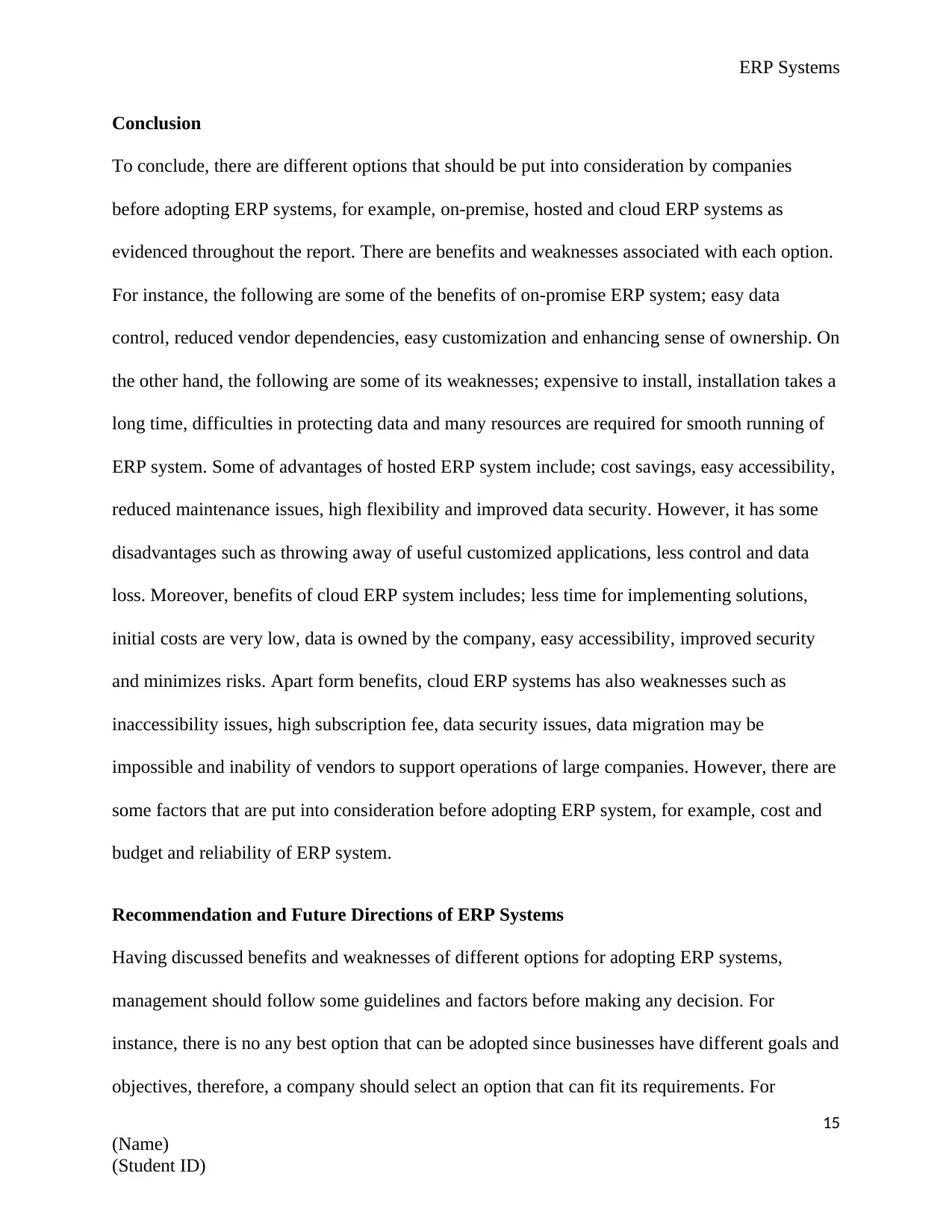
ERP Systems
Conclusion
To conclude, there are different options that should be put into consideration by companies
before adopting ERP systems, for example, on-premise, hosted and cloud ERP systems as
evidenced throughout the report. There are benefits and weaknesses associated with each option.
For instance, the following are some of the benefits of on-promise ERP system; easy data
control, reduced vendor dependencies, easy customization and enhancing sense of ownership. On
the other hand, the following are some of its weaknesses; expensive to install, installation takes a
long time, difficulties in protecting data and many resources are required for smooth running of
ERP system. Some of advantages of hosted ERP system include; cost savings, easy accessibility,
reduced maintenance issues, high flexibility and improved data security. However, it has some
disadvantages such as throwing away of useful customized applications, less control and data
loss. Moreover, benefits of cloud ERP system includes; less time for implementing solutions,
initial costs are very low, data is owned by the company, easy accessibility, improved security
and minimizes risks. Apart form benefits, cloud ERP systems has also weaknesses such as
inaccessibility issues, high subscription fee, data security issues, data migration may be
impossible and inability of vendors to support operations of large companies. However, there are
some factors that are put into consideration before adopting ERP system, for example, cost and
budget and reliability of ERP system.
Recommendation and Future Directions of ERP Systems
Having discussed benefits and weaknesses of different options for adopting ERP systems,
management should follow some guidelines and factors before making any decision. For
instance, there is no any best option that can be adopted since businesses have different goals and
objectives, therefore, a company should select an option that can fit its requirements. For
15
(Name)
(Student ID)
Conclusion
To conclude, there are different options that should be put into consideration by companies
before adopting ERP systems, for example, on-premise, hosted and cloud ERP systems as
evidenced throughout the report. There are benefits and weaknesses associated with each option.
For instance, the following are some of the benefits of on-promise ERP system; easy data
control, reduced vendor dependencies, easy customization and enhancing sense of ownership. On
the other hand, the following are some of its weaknesses; expensive to install, installation takes a
long time, difficulties in protecting data and many resources are required for smooth running of
ERP system. Some of advantages of hosted ERP system include; cost savings, easy accessibility,
reduced maintenance issues, high flexibility and improved data security. However, it has some
disadvantages such as throwing away of useful customized applications, less control and data
loss. Moreover, benefits of cloud ERP system includes; less time for implementing solutions,
initial costs are very low, data is owned by the company, easy accessibility, improved security
and minimizes risks. Apart form benefits, cloud ERP systems has also weaknesses such as
inaccessibility issues, high subscription fee, data security issues, data migration may be
impossible and inability of vendors to support operations of large companies. However, there are
some factors that are put into consideration before adopting ERP system, for example, cost and
budget and reliability of ERP system.
Recommendation and Future Directions of ERP Systems
Having discussed benefits and weaknesses of different options for adopting ERP systems,
management should follow some guidelines and factors before making any decision. For
instance, there is no any best option that can be adopted since businesses have different goals and
objectives, therefore, a company should select an option that can fit its requirements. For
15
(Name)
(Student ID)
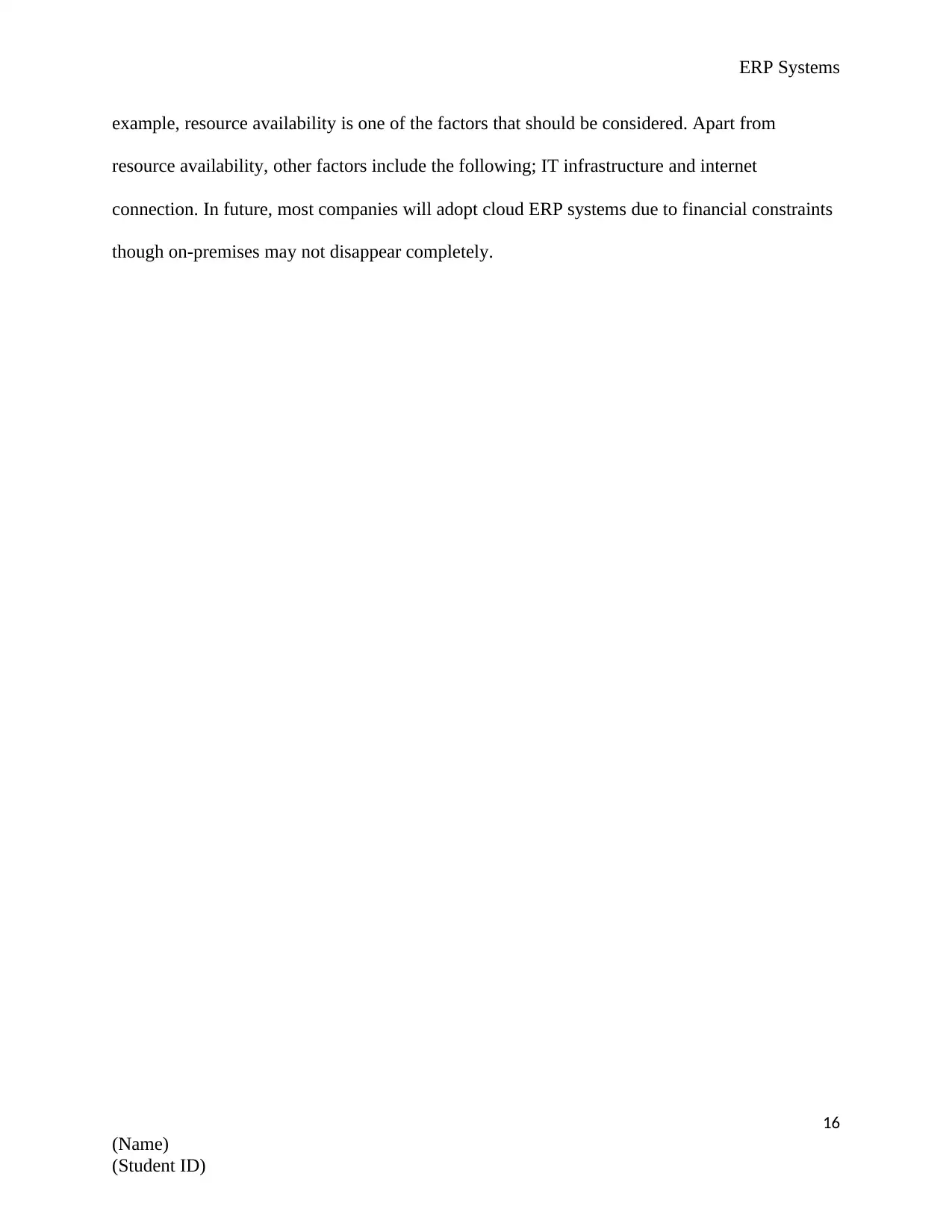
ERP Systems
example, resource availability is one of the factors that should be considered. Apart from
resource availability, other factors include the following; IT infrastructure and internet
connection. In future, most companies will adopt cloud ERP systems due to financial constraints
though on-premises may not disappear completely.
16
(Name)
(Student ID)
example, resource availability is one of the factors that should be considered. Apart from
resource availability, other factors include the following; IT infrastructure and internet
connection. In future, most companies will adopt cloud ERP systems due to financial constraints
though on-premises may not disappear completely.
16
(Name)
(Student ID)
Secure Best Marks with AI Grader
Need help grading? Try our AI Grader for instant feedback on your assignments.
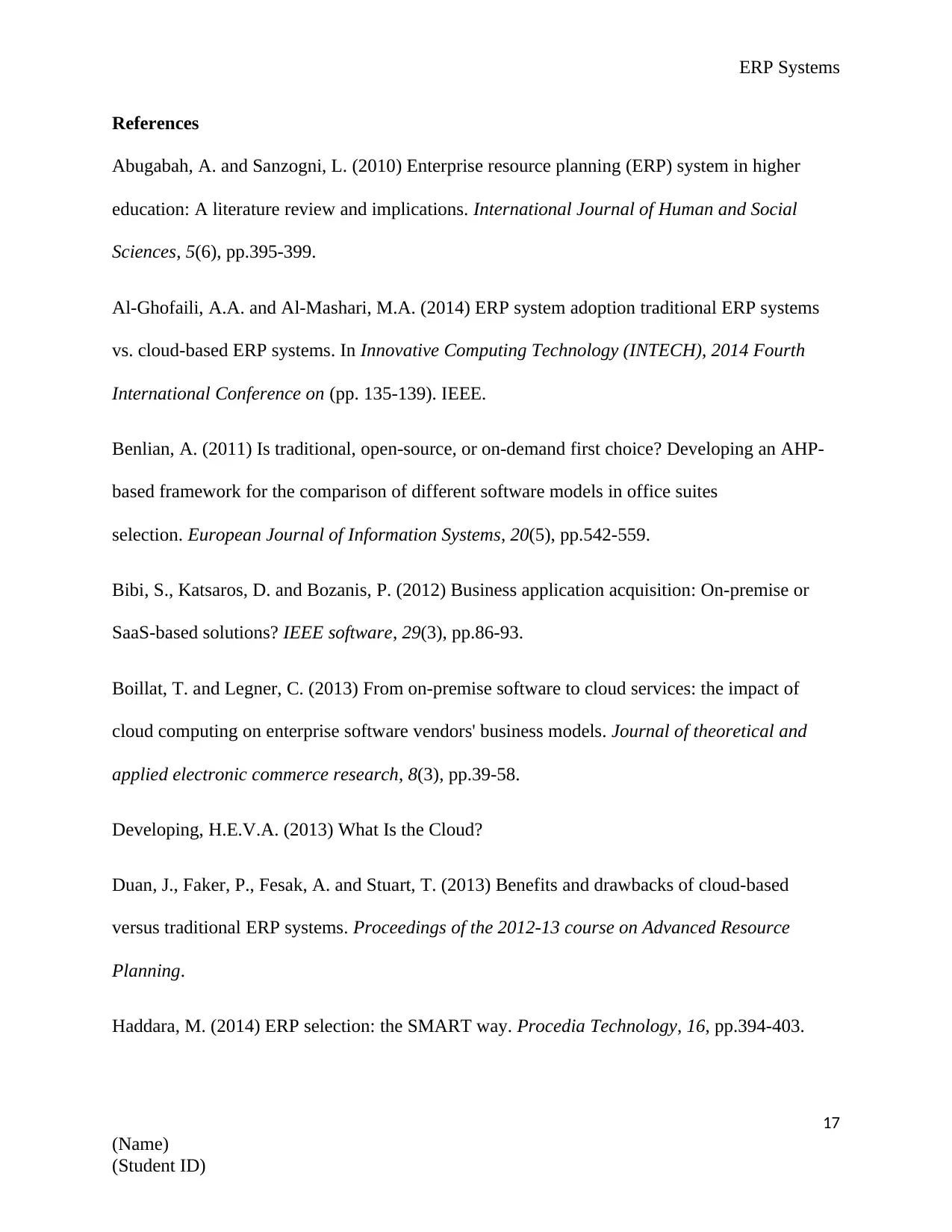
ERP Systems
References
Abugabah, A. and Sanzogni, L. (2010) Enterprise resource planning (ERP) system in higher
education: A literature review and implications. International Journal of Human and Social
Sciences, 5(6), pp.395-399.
Al-Ghofaili, A.A. and Al-Mashari, M.A. (2014) ERP system adoption traditional ERP systems
vs. cloud-based ERP systems. In Innovative Computing Technology (INTECH), 2014 Fourth
International Conference on (pp. 135-139). IEEE.
Benlian, A. (2011) Is traditional, open-source, or on-demand first choice? Developing an AHP-
based framework for the comparison of different software models in office suites
selection. European Journal of Information Systems, 20(5), pp.542-559.
Bibi, S., Katsaros, D. and Bozanis, P. (2012) Business application acquisition: On-premise or
SaaS-based solutions? IEEE software, 29(3), pp.86-93.
Boillat, T. and Legner, C. (2013) From on-premise software to cloud services: the impact of
cloud computing on enterprise software vendors' business models. Journal of theoretical and
applied electronic commerce research, 8(3), pp.39-58.
Developing, H.E.V.A. (2013) What Is the Cloud?
Duan, J., Faker, P., Fesak, A. and Stuart, T. (2013) Benefits and drawbacks of cloud-based
versus traditional ERP systems. Proceedings of the 2012-13 course on Advanced Resource
Planning.
Haddara, M. (2014) ERP selection: the SMART way. Procedia Technology, 16, pp.394-403.
17
(Name)
(Student ID)
References
Abugabah, A. and Sanzogni, L. (2010) Enterprise resource planning (ERP) system in higher
education: A literature review and implications. International Journal of Human and Social
Sciences, 5(6), pp.395-399.
Al-Ghofaili, A.A. and Al-Mashari, M.A. (2014) ERP system adoption traditional ERP systems
vs. cloud-based ERP systems. In Innovative Computing Technology (INTECH), 2014 Fourth
International Conference on (pp. 135-139). IEEE.
Benlian, A. (2011) Is traditional, open-source, or on-demand first choice? Developing an AHP-
based framework for the comparison of different software models in office suites
selection. European Journal of Information Systems, 20(5), pp.542-559.
Bibi, S., Katsaros, D. and Bozanis, P. (2012) Business application acquisition: On-premise or
SaaS-based solutions? IEEE software, 29(3), pp.86-93.
Boillat, T. and Legner, C. (2013) From on-premise software to cloud services: the impact of
cloud computing on enterprise software vendors' business models. Journal of theoretical and
applied electronic commerce research, 8(3), pp.39-58.
Developing, H.E.V.A. (2013) What Is the Cloud?
Duan, J., Faker, P., Fesak, A. and Stuart, T. (2013) Benefits and drawbacks of cloud-based
versus traditional ERP systems. Proceedings of the 2012-13 course on Advanced Resource
Planning.
Haddara, M. (2014) ERP selection: the SMART way. Procedia Technology, 16, pp.394-403.
17
(Name)
(Student ID)
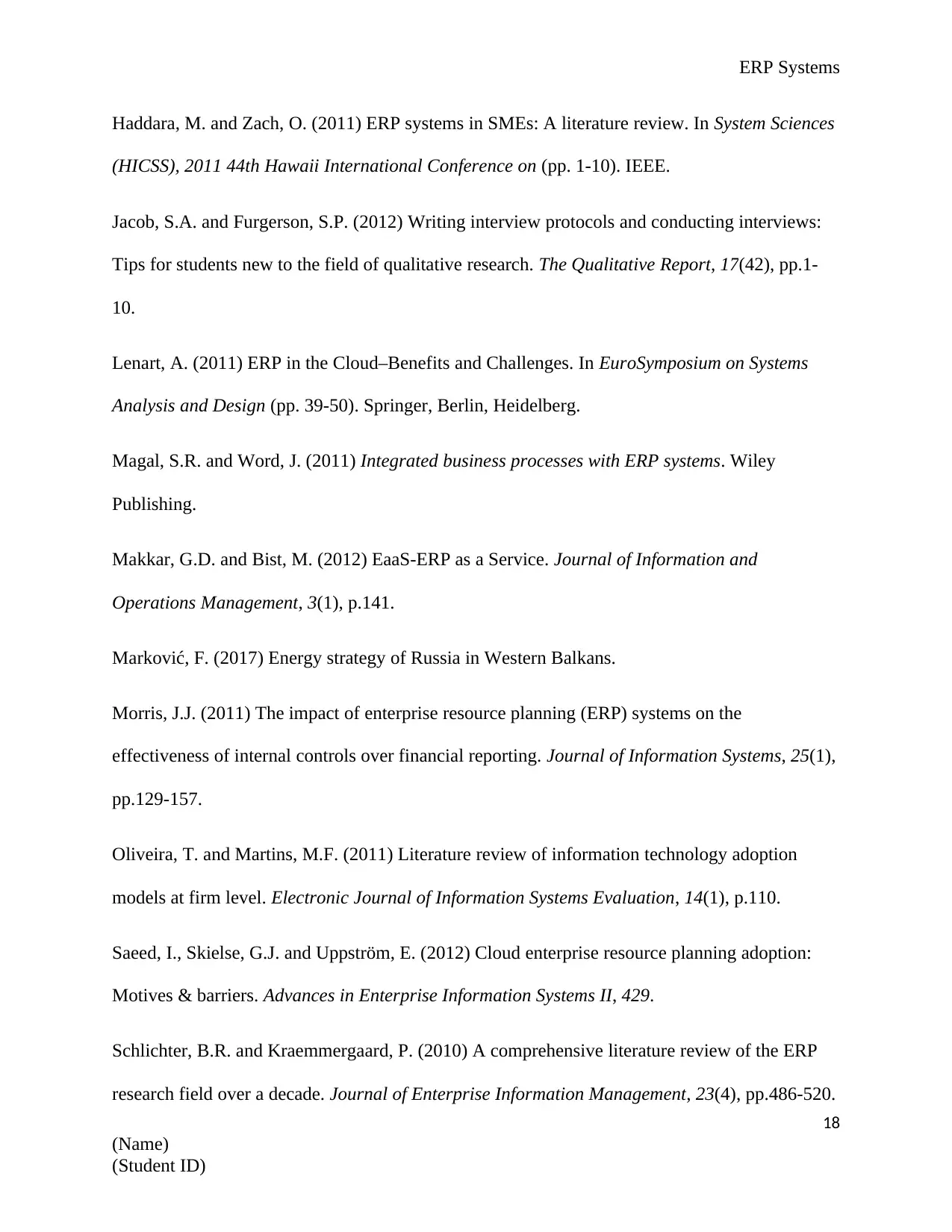
ERP Systems
Haddara, M. and Zach, O. (2011) ERP systems in SMEs: A literature review. In System Sciences
(HICSS), 2011 44th Hawaii International Conference on (pp. 1-10). IEEE.
Jacob, S.A. and Furgerson, S.P. (2012) Writing interview protocols and conducting interviews:
Tips for students new to the field of qualitative research. The Qualitative Report, 17(42), pp.1-
10.
Lenart, A. (2011) ERP in the Cloud–Benefits and Challenges. In EuroSymposium on Systems
Analysis and Design (pp. 39-50). Springer, Berlin, Heidelberg.
Magal, S.R. and Word, J. (2011) Integrated business processes with ERP systems. Wiley
Publishing.
Makkar, G.D. and Bist, M. (2012) EaaS-ERP as a Service. Journal of Information and
Operations Management, 3(1), p.141.
Marković, F. (2017) Energy strategy of Russia in Western Balkans.
Morris, J.J. (2011) The impact of enterprise resource planning (ERP) systems on the
effectiveness of internal controls over financial reporting. Journal of Information Systems, 25(1),
pp.129-157.
Oliveira, T. and Martins, M.F. (2011) Literature review of information technology adoption
models at firm level. Electronic Journal of Information Systems Evaluation, 14(1), p.110.
Saeed, I., Skielse, G.J. and Uppström, E. (2012) Cloud enterprise resource planning adoption:
Motives & barriers. Advances in Enterprise Information Systems II, 429.
Schlichter, B.R. and Kraemmergaard, P. (2010) A comprehensive literature review of the ERP
research field over a decade. Journal of Enterprise Information Management, 23(4), pp.486-520.
18
(Name)
(Student ID)
Haddara, M. and Zach, O. (2011) ERP systems in SMEs: A literature review. In System Sciences
(HICSS), 2011 44th Hawaii International Conference on (pp. 1-10). IEEE.
Jacob, S.A. and Furgerson, S.P. (2012) Writing interview protocols and conducting interviews:
Tips for students new to the field of qualitative research. The Qualitative Report, 17(42), pp.1-
10.
Lenart, A. (2011) ERP in the Cloud–Benefits and Challenges. In EuroSymposium on Systems
Analysis and Design (pp. 39-50). Springer, Berlin, Heidelberg.
Magal, S.R. and Word, J. (2011) Integrated business processes with ERP systems. Wiley
Publishing.
Makkar, G.D. and Bist, M. (2012) EaaS-ERP as a Service. Journal of Information and
Operations Management, 3(1), p.141.
Marković, F. (2017) Energy strategy of Russia in Western Balkans.
Morris, J.J. (2011) The impact of enterprise resource planning (ERP) systems on the
effectiveness of internal controls over financial reporting. Journal of Information Systems, 25(1),
pp.129-157.
Oliveira, T. and Martins, M.F. (2011) Literature review of information technology adoption
models at firm level. Electronic Journal of Information Systems Evaluation, 14(1), p.110.
Saeed, I., Skielse, G.J. and Uppström, E. (2012) Cloud enterprise resource planning adoption:
Motives & barriers. Advances in Enterprise Information Systems II, 429.
Schlichter, B.R. and Kraemmergaard, P. (2010) A comprehensive literature review of the ERP
research field over a decade. Journal of Enterprise Information Management, 23(4), pp.486-520.
18
(Name)
(Student ID)

ERP Systems
Scholtz, B. and Atukwase, D. (2016) An analysis of the perceived benefits and drawbacks of
cloud ERP systems: A South African study. In Information Technology in Environmental
Engineering (pp. 75-87). Springer, Cham.
Shukla, S., Agarwal, S. and Shukla, A. (2012) Trends in Cloud-ERP for SMB’s: A
Review. International Journal of New Innovations in Engineering and Technology
(IJNIET), 1(1), pp.7-11.
Strom, K., Berzofsky, M., Shook-Sa, B., Barrick, K., Daye, C., Horstmann, N. and Kinsey, S.
(2010) The private security industry: A review of the definitions, available data sources, and
paths moving forward. US Department of Justice and National Criminal Justice Reference
Service, Final Report.
Utzig, C., Holland, D., Horvath, M. and Manohar, M. (2013) ERP in the Cloud Is It Ready? Are
You? Perspective, pp.1-9.
Weng, F. and Hung, M.C. (2014) Competition and challenge on adopting cloud
ERP. International Journal of Innovation, Management and Technology, 5(4), p.309.
Winkler, T.J. and Brown, C.V. (2013) Horizontal allocation of decision rights for on-premise
applications and software-as-a-service. Journal of Management Information Systems, 30(3),
pp.13-48.
19
(Name)
(Student ID)
Scholtz, B. and Atukwase, D. (2016) An analysis of the perceived benefits and drawbacks of
cloud ERP systems: A South African study. In Information Technology in Environmental
Engineering (pp. 75-87). Springer, Cham.
Shukla, S., Agarwal, S. and Shukla, A. (2012) Trends in Cloud-ERP for SMB’s: A
Review. International Journal of New Innovations in Engineering and Technology
(IJNIET), 1(1), pp.7-11.
Strom, K., Berzofsky, M., Shook-Sa, B., Barrick, K., Daye, C., Horstmann, N. and Kinsey, S.
(2010) The private security industry: A review of the definitions, available data sources, and
paths moving forward. US Department of Justice and National Criminal Justice Reference
Service, Final Report.
Utzig, C., Holland, D., Horvath, M. and Manohar, M. (2013) ERP in the Cloud Is It Ready? Are
You? Perspective, pp.1-9.
Weng, F. and Hung, M.C. (2014) Competition and challenge on adopting cloud
ERP. International Journal of Innovation, Management and Technology, 5(4), p.309.
Winkler, T.J. and Brown, C.V. (2013) Horizontal allocation of decision rights for on-premise
applications and software-as-a-service. Journal of Management Information Systems, 30(3),
pp.13-48.
19
(Name)
(Student ID)
1 out of 19
Related Documents
Your All-in-One AI-Powered Toolkit for Academic Success.
+13062052269
info@desklib.com
Available 24*7 on WhatsApp / Email
![[object Object]](/_next/static/media/star-bottom.7253800d.svg)
Unlock your academic potential
© 2024 | Zucol Services PVT LTD | All rights reserved.


